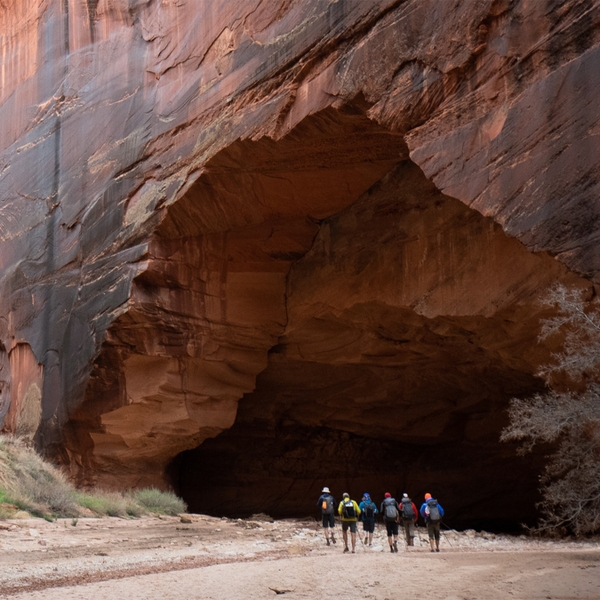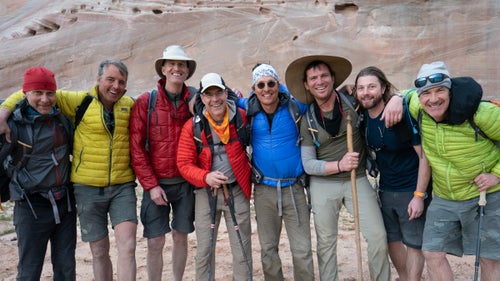In the World of Ultralight Hiking, Everything Weighs Something
On a backpacking trip through Utah’s Buckskin Gulch with ultralight gear legend Glen Van Peski, our writer learns about the Crotch Pot, an Oscar-winning actor’s anti-snoring technique, and that there’s a whole lot of shit you don’t need when you’re on the trail 1,000 miles from home
New perk: Easily find new routes and hidden gems, upcoming running events, and more near you. Your weekly Local Running Newsletter has everything you need to lace up! .
They tell me Glen Van Peski is a celebrity, but he remains largely ignored where I first meet him: in Las Vegas in the lobby of the Cosmopolitan Hotel. Glen is hard to miss. At six feet four inches, he towers over me as he peers way, way down below in search of my hand for our initial greeting. While everyone else in the lobby is dressed for dining or gambling or in what they think a celebrity might wear, Glen is wearing tomorrow’s hiking clothes today: quick-dry shirt, convertible pant-shorts zippered at the knee, and Altra Lone Peak foot-shaped minimalist hiking shoes cinched up with brand-new laces.
Glen likes to be ready. He wants to know everything fits and is in working order and that there isn’t too much of it. For Glen, and anyone traveling with him, having too much gear might be worse than having no gear at all.
A couple weeks prior to meeting Glen, my college buddy Dan Buettner invited me to join a group of his friends on an ultralightweight hike through Utah’s —led by, according to Dan, a mythical legend named . Most of the group would convene at the Cosmopolitan, the last civilized outpost before heading into a wilderness where there are no bed linens, pulsating showerheads, or flushing toilets.
Glen’s long arms and legs qualify as lanky, but his accomplishments, confidence, and clarity give him a muscular air of leadership. His angular, expressive face and bald head simultaneously project wit, wisdom, curiosity, delight, and dead seriousness. Five minutes after we meet, he notices my overstuffed pack and suggests we go up to his room, where he’ll teach me how to lighten my load—literally, but also, I soon learn, metaphorically.
Riding the elevator, I notice that Glen talks in numbers more than words—grams and ounces, miles and kilometers. Arithmophobia may be an actual affliction, or maybe I made it up as a clinical-sounding excuse to explain my shortcomings. Either way, I suffer from a fear of math, numbers, and quantification. For example, when I hear Neil Young sing the lyric “She’s been running half her life,” I worry that I’ll be forced into dividing some unknown number by two before I can feel the emotion of the song.
Before Dan’s invitation, I’d never heard of Buckskin Gulch, a bucket-list destination for hikers and canyoneers in the of southern Utah. A creek runs through the gulch for part of the year and feeds into the Paria River, which in turn joins the Colorado River southwest of the Glen Canyon Dam. Numbers that turned up in a Google search about Buckskin terrified me: it is one of the world’s longest slot canyons (15 miles), among the deepest (500 feet), and at times as narrow as two feet. Claustrophobic. Articles warned of subfreezing temperatures and flash flooding. Even…fatalities?
I said, “Sure, I’ll be there.”
Dan Buettner is a National Geographic fellow and bestselling author. He holds three Guinness records for endurance cycling. He created the concept of Blue Zones, regions in the world where people live longer and better. His life is an adventure, and he is often exploring another corner of the world accompanied by diverse groups of friends.
There would be eight of us hiking Buckskin: Dan’s longtime collaborator, National Geographic photographer ; CNN correspondent ; hotel entrepreneur ; Ed Driscoll, CEO of ; Oscar-winning actor Matthew McConaughey; and me, who is often asked a question Matthew McConaughey never gets asked: “What have you done that I would have seen?”
When Dan called, I was completing a writing job for Netflix. I had once again been lulled into the artifice of Hollywood. “Real” to me meant a catered lunch delivered to my desk daily. I hoped a serious hike would recalibrate my senses.









